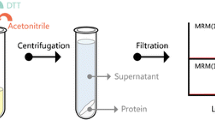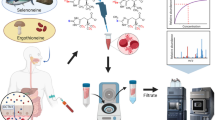Abstract
Total homocysteine (tHCY) and folate are interrelated biomarkers for arteriosclerosis and coronary heart disease. Although many different methods for both tHCY and folate are clinically available, the intermethod and interlaboratory results are often poor, resulting in the need for a matrix reference material and reference methods. The National Institute of Standards and Technology (NIST) has developed isotope dilution liquid chromatography/mass spectrometry (LC/MS) and liquid chromatography/ tandem mass spectrometry (LC/MS/MS) methods for determination of tHCY and several folate forms including 5-methyltetrahydrofolic acid (5MT) and folic acid (FA). Additionally, a method for simultaneous measurement of tHCY, 5MT, and FA has been developed and validated. In collaboration with the Centers for Disease Control and Prevention (CDC), mass spectrometric methods and methods used in clinical laboratories have been applied to characterize a new Standard Reference Material (SRM), SRM 1955, “Homocysteine and Folate in Human Serum,” containing low, medium, and high levels of tHCY and 5MT. Additionally, FA, 5-formyltetrahydrofolic acid (5FT), vitamin B12, and total folate values are provided. Use of the new SRM should improve clinical measurements and will permit traceability to internationally recognized certified reference materials, as described by European Directive 98/79/EC on in vitro diagnostic medical devices.





Similar content being viewed by others
References
Boushey CJ, Beresford SA, Omenn GS, Motulsky AG (1995) A quantitative assessment of plasma homocysteine as a risk factor for vascular disease. Probable benefits of increasing folic acid intakes. JAMA 274:1049–1057
Refsum H, Ueland PM, Nygard O, Vollset SE (1998) Homocysteine and cardiovascular disease. Annu Rev Med 49:31–62
Weiss N, Hilge R, Hoffmann U (2004) Mild hyperhomocysteinemia: risk factor or just risk predictor for cardiovascular diseases? Vasa 33:191–203
MRC Vitamin Study Research Group (1991) Prevention of neural tube defects: results of the Medical Research Council Vitamin Study. Lancet 338:131–137
Pfeiffer CM, Fazili Z, McCoy L, Zhang M, Gunter EW (2004) Determination of folate vitamers in human serum by stable-isotope-dilution tandem mass spectrometry and comparison with radioassay and microbiologic assay. Clin Chem 50:423–432
Honein MA, Paulozzi LJ, Mathews TJ, Erickson JD, Wong LY (2001) Impact of folic acid fortification of the US food supply on the occurrence of neural tube defects. JAMA 285:2981–2986
Schnyder G, Roffi M, Pin R, Flammer Y, Lange H, Eberli FR et al (2001) Decreased rate of coronary restenosis after lowering of plasma homocysteine levels. N Engl J Med 345:1593–1600
Choi SW, Mason JB (2002) Folate status: effects on pathways of colorectal carcinogenesis. J Nutr 132:2413S–2418S
D’Eramo JL, Finkelstein AE, Boccazzi FO, Fridman O (1998) Total homocysteine levels in plasma: high-performance liquid chromatographic determination with electrochemical detection and glassy carbon electrode. J Chromatogr B 720(1–2):205–210
Frantzen F, Faaren AL, Alfheim I, Nordhei AK (1998) Enzyme conversion immunoassay for determining total homocysteine in plasma or serum. Clin Chem 44:311–316
Marangon K, O’Byrne D, Devaraj S, Jialal I (1999) Validation of an immunoassay for measurement of plasma total homocysteine. Am J Clin Path 112:757–762
Pfeiffer CM, Huff DL, Gunter EW (1999) Rapid and accurate HPLC assay for plasma total homocysteine and cysteine in a clinical laboratory setting. Clin Chem 45:290–293
Stabler SP, Lindenbaum J, Savage DG, Allen RH (1993) Elevation of serum cystathionine levels in patients with cobalamin and folate deficiency. Blood 81:3404–3413
Gempel K, Gerbitz K-D, Casetta B, Bauer MF (2000) Rapid determination of total homocysteine in blood spots by liquid chromatography-electrospray ionization-tandem mass spectrometry. Clin Chem 46:122–123
Magera MJ, Lacey JM, Casetta B, Rinaldo P (1999) Method for the determination of total homocysteine in plasma and urine by stable isotope dilution and electrospray tandem mass spectrometry. Clin Chem 45:1517–1522
Nelson B, Pfeiffer CM, Sniegoski LT, Satterfield MB (2003) Development and evaluation of an isotope dilution LC/MS method for the determination of total homocysteine in human plasma. Anal Chem 75:775–784
Nexo E, Engbaek F, Ueland PM, Westby C, O’Gorman P, Johnston C et al (2000) Evaluation of novel assays in clinical chemistry: quantification of plasma total homocysteine. Clin Chem 46:1150–1156
Tripodi A, Chantarangkul V, Lombardi R, Lecchi A, Mannucci PM, Cattaneo M (2001) Multicenter study of homocysteine measurement-performance characteristics of different methods, influence of standards on interlaboratory agreement of results. Thromb Haemost 85:291–295
Molloy AM, Scott JM (1997) Microbiological assay for serum, plasma, and red cell folate using cryopreserved, microtiter plate method. Methods Enzymol 281:43–53, 43–53
O’Broin S, Kelleher B (1992) Microbiological assay on microtitre plates of folate in serum and red cells. J Clin Pathol 45:344–347
Bio-Rad Laboratories (1993) Instruction manual, bio-rad quantaphase II folate/B12 radioassay kit. Bio-Rad Laboratories, Hercules, CA
Gunter EW, Bowman BA, Caudill SP, Twite DB, Adams MJ, Sampson EJ (1996) Results of an international round robin for serum and whole-blood folate. Clin Chem 42:1689–1694
Bagley PJ, Selhub J (2000) Analysis of folate form distribution by affinity followed by reversed-phase chromatography with electrical detection. Clin Chem 46:404–411
Lucock MD, Hartley R, Smithells RW (1989) A rapid and specific HPLC-electrochemical method for the determination of endogenous 5-methyltetrahydrofolic acid in plasma using solid phase sample preparation with internal standardization. Biomed Chromatogr 3:58–63
Hart DJ, Finglas PM, Wolfe CA, Mellon F, Wright AJ, Southon S (2002) Determination of 5-methyltetrahydrofolate (13C-labeled and unlabeled) in human plasma and urine by combined liquid chromatography mass spectrometry. Anal Biochem 305:206–213
Nelson BC, Dalluge JJ, Margolis SA (2001) Preliminary application of liquid chromatography-electrospray-ionization mass spectrometry to the detection of 5-methyltetrahydrofolic acid monoglutamate in human plasma. J Chromatogr B Biomed Sci Appl 765:141–150
Nelson BC, Pfeiffer CM, Margolis SA, Nelson CP (2003) Affinity extraction combined with stable isotope dilution LC/MS for the determination of 5-methyltetrahydrofolate in human plasma. Anal Biochem 313:117–127
Nelson BC, Pfeiffer CM, Margolis SA, Nelson CP (2004) Solid-phase extraction-electrospray ionization mass spectrometry for the quantification of folate in human plasma or serum. Anal Biochem 325:41–51
Pawlosky RJ, Flanagan VP, Pfeiffer CM (2001) Determination of 5-methyltetrahydrofolic acid in human serum by stable-isotope dilution high-performance liquid chromatography-mass spectrometry. Anal Biochem 298:299–305
Nelson BC, Satterfield MB, Sniegoski LT, Welch MJ (2005) Simultaneous quantification of homocysteine and folate in human serum or plasma using liquid chromatography/tandem mass spectrometry. Anal Chem 77:3586–3593
Guide to the expression of uncertainty in measurement, 1st edn. Geneva, Switzerland: ISO, 1993
Levenson MS, Banks DL, Eberhardt KR, Gill LM, Guthrie WF, Liu HK et al (2000) An approach to combining results from multiple methods motivated by the ISO GUM. J Res Natl Inst Stand Technol 105:571–579
Liu H-K, Zhang NF (2001) Bayesian approach to combining results from multiple methods. Proceedings of the Section of Bayesian Statistical Science of American Statistical Society
Satterfield MB, Sniegoski LT, Welch MJ, Nelson BC, Pfeiffer CM (2003) Comparison of isotope dilution mass spectrometry methods for the determination of total homocysteine in plasma and serum. Anal Chem 75:4631–4638
Pfeiffer CM, Twite D, Shih J, Holets-McCormack SR, Gunter EW (1999) Method comparison for total plasma homocysteine between the Abbott IMx analyzer and an HPLC assay with internal standardization. Clin Chem 45:152–153
Shipchandler MT, Moore EG (1995) Rapid, fully automated measurement of plasma homocyst(e)ine with the Abbott IMx analyzer. Clin Chem 41:991–994
Hornikova A, Zhang NF, Welch MJ, Tai S (2006) An application of combining results from multiple methods-statistical evaluation of uncertainty for NIST SRM 1508a. Metrologia 43:205–212
Acknowledgements
Sonya Strider (FPIA) and Lily Jia (BioRad).
Author information
Authors and Affiliations
Corresponding author
Rights and permissions
About this article
Cite this article
Satterfield, M.B., Sniegoski, L.T., Sharpless, K.E. et al. Development of a new standard reference material: SRM 1955 (homocysteine and folate in human serum). Anal Bioanal Chem 385, 612–622 (2006). https://doi.org/10.1007/s00216-006-0434-1
Received:
Revised:
Accepted:
Published:
Issue Date:
DOI: https://doi.org/10.1007/s00216-006-0434-1




